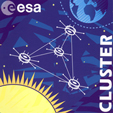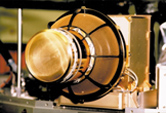Principle of Operation of CODIF
The instrument combines the selection of incoming ions according to energy per charge by electrostatic deflection in a toroidal analyzer with post-acceleration by up to 20 keV/e and subsequent TOF analysis.The electrostatic analyzer (ESA) is of a toroidal top-hat type with a uniform response over 360° of polar angle. As illustrated in Fig. 1, the analyzer consists of an inner toroid, to which a variable negative potential is applied, an outer toroid with a cut-out at the top, and a top-cap lifted above the outer toroid. Both, the outer toroid and the top-cap are normally held at ground potential, thereby exposing no high voltage to the outside world. A beam of parallel ion trajectories entering the aperture is focused to a certain location at the exit plane of the analyzer. This location determines the incident polar angle of the ions. With a cross-plate voltage of 2-5200 V (varied with logarithmically spaced steps), the energy range is 15-40000 eV/e. The analyzer has an intrinsic energy resolution of dE/E ~ 0.13. It is surrounded by a cylindrical collimator which serves to define the acceptance angles. The full polar angle of the analyzer is divided into 16 pixels of 22.5° each. The full energy sweep will be performed 32 times per spin. Thus a two dimensional cut through the distribution in polar angle with 11.25° resolution in azimuthal angle is obtained every 1/32 of a spin period. The entrance apertures of CODIF provides two different geometrical factors in order to maximize the dynamic range of the instruments, with the geometric factor in the second half attenuated by a factor of 100 using an array of pin holes.
Behind the electrostatic analyzer the ions are accelerated by a voltage of -10 to -20 kV, such that the ions have a minimum energy before entering the TOF section. The energy per charge E/Q as selected by the ESA plus the energy e . UACC gained by post-acceleration and the measured time-of-flight t through the length d of the TOF unit are combined into the mass per charge M/Q of the ion according to:
M/Q = 2ß(E/Q + e . UACC)/(d/t)2.
The quantity ß represents the effect of energy loss in the thin carbon foil
(3 µg/cm2) at the entry of the TOF section and depends on particle species and incident energy. The start signal is provided by secondary electrons, that are emitted from the carbon foil during the passage of the ions. The electrons are accelerated and deflected onto the start portion of the microchannel plate (MCP) by the appropriate potential configuration. The secondary electrons also provide the position information for the angular sectoring. The stop signal is provided by secondary electrons generated by the ions hitting the stop portion of the same MCP.








